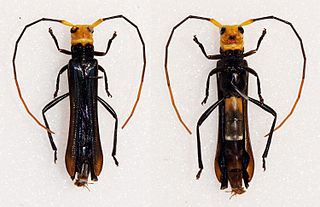
The flannel moths or crinkled flannel moths are a family of insects. They occur in North America and the New World tropics. The larvae are called puss caterpillars, and with their long hairs, resemble cotton balls. They have venomous spines that can cause a painful sting and inflammation lasting for several days. In some cases, the sting may cause headache, nausea, and shock-like symptoms. Perhaps the most notorious for stinging is the caterpillar of Megalopyge opercularis.

Paralaoma is a genus of very small air-breathing land snails, terrestrial pulmonate gastropod mollusks or micromollusks in the family Punctidae, the dot snails.

Paralaoma servilis is a species of very small air-breathing land snail, a terrestrial pulmonate gastropod mollusk or micromollusk in the family Punctidae, the dot snails.
Andrea Servili is an Italian football coach and a former goalkeeper who works as a goalkeeping coach with Alessandria.
Hysterocladia is a genus of moths in the family Megalopygidae.
Halone servilis is a moth of the subfamily Arctiinae. It was described by Edward Meyrick in 1886. It is found in Australia.

Neonitocris is a genus of longhorn beetles of the subfamily Lamiinae, containing the following species:
Pterolophia servilis is a species of beetle in the family Cerambycidae. It was described by Stephan von Breuning in 1938.
Neonitocris servilis is a species of beetle in the family Cerambycidae. It was described by Karl Jordan in 1894.
Hysterocladia tolimensis is a moth of the family Megalopygidae. It was described by Walter Hopp in 1927. It is found in Colombia.
Hysterocladia werneri is a moth of the family Megalopygidae. It was described by Walter Hopp in 1927. It is found in Colombia.
Hysterocladia elongata is a moth of the family Megalopygidae. It was described by Walter Hopp in 1927. It is found in Peru.
Hysterocladia ferecostata is a moth of the family Megalopygidae. It was described by Walter Hopp in 1927. It is found in Peru.
Hysterocladia primigenia is a moth of the family Megalopygidae. It was described by Walter Hopp in 1927. It is found in Peru.
Hysterocladia corallocera is a moth of the Megalopygidae family. It was described by Felder in 1874. It is found in Venezuela and French Guiana.
Hysterocladia eriphua is a moth of the Megalopygidae family. It was described by Paul Dognin in 1914. It is found in Panama.
Hysterocladia lena is a moth of the Megalopygidae family. It was described by Schaus in 1912. It is found in Costa Rica.
Hysterocladia roseicollis is a moth of the Megalopygidae family. It was described by Paul Dognin in 1914. It is found in Peru and French Guiana.
Hysterocladia unimana is a moth of the family Megalopygidae. It was described by Walter Hopp in 1943. It is found in Brazil.
Neonteichos was a fortified town on the coast of ancient Thrace, mentioned in the Periplus of Pseudo-Scylax and by Xenophon.


